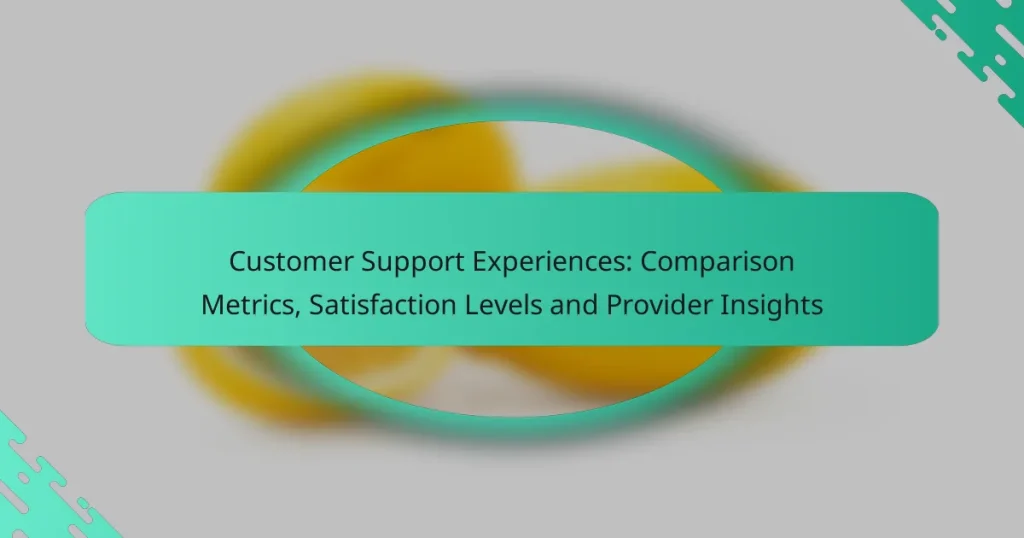Customer support experiences play a crucial role in shaping customer satisfaction and loyalty, with significant variations across different providers. Metrics such as response times, resolution rates, and the quality of interactions are essential in evaluating the effectiveness of support services. Understanding these factors can help businesses enhance their customer support strategies and address common challenges that may hinder customer satisfaction.

How do customer support experiences compare across providers?
Customer support experiences vary significantly across providers, impacting customer satisfaction and loyalty. Key factors include response times, resolution rates, and the overall quality of interactions, which can differ based on the industry and service model.
Provider A vs. Provider B comparison
Provider A typically offers faster response times, averaging around 5 minutes for initial contact, while Provider B may take up to 15 minutes. However, Provider B excels in resolution rates, resolving issues on the first contact approximately 80% of the time compared to Provider A’s 65%.
When comparing customer service channels, Provider A focuses heavily on live chat, which appeals to tech-savvy users, whereas Provider B provides a more balanced approach with phone support and email options, catering to a broader audience.
Key metrics for evaluation
Key metrics for evaluating customer support include average response time, first contact resolution rate, and customer satisfaction scores. These metrics help gauge the efficiency and effectiveness of support services.
For instance, a good average response time is typically under 10 minutes, while a first contact resolution rate above 70% is considered excellent. Regularly tracking these metrics can help identify areas for improvement.
Customer feedback analysis
Customer feedback is crucial for understanding support experiences. Analyzing reviews and survey responses can reveal common pain points, such as long wait times or unhelpful responses.
Utilizing tools like Net Promoter Score (NPS) and Customer Satisfaction Score (CSAT) can provide quantitative insights into customer perceptions. Regularly reviewing this feedback allows providers to adapt and enhance their support strategies effectively.

What metrics determine customer satisfaction in support?
Customer satisfaction in support is primarily determined by metrics that reflect the efficiency and effectiveness of service interactions. Key metrics include response time, resolution rate, and customer effort score, each providing insights into how well customer needs are met.
Response time metrics
Response time metrics measure how quickly a support team acknowledges and addresses customer inquiries. This can range from immediate responses in live chat to several hours for email support. Generally, a response time of under five minutes is ideal for live channels, while email responses should aim for less than 24 hours.
To improve response times, consider implementing automated responses for common queries and ensuring adequate staffing during peak hours. Regularly reviewing these metrics helps identify trends and areas needing improvement.
Resolution rate statistics
Resolution rate statistics indicate the percentage of customer issues resolved on the first contact. A high resolution rate, typically above 70%, signifies effective support processes and knowledgeable staff. This metric is crucial as it directly correlates with customer satisfaction levels.
To enhance resolution rates, invest in comprehensive training for support agents and maintain a well-organized knowledge base. Monitoring this metric can help identify recurring issues that may require systemic changes.
Customer effort score
The customer effort score (CES) measures how easy it is for customers to get their issues resolved. A lower score indicates that customers find it challenging to navigate the support process, which can lead to dissatisfaction. Aiming for a CES below three on a scale of one to seven is generally considered favorable.
To reduce customer effort, streamline communication channels and provide clear, concise instructions for common issues. Regularly solicit feedback on the support experience to identify pain points and make necessary adjustments.

What are the common challenges in customer support?
Common challenges in customer support include long wait times, lack of personalized service, and inconsistent information. These issues can significantly impact customer satisfaction and loyalty, making it essential for businesses to address them effectively.
Long wait times
Long wait times are a frequent complaint among customers seeking support. When customers have to wait for extended periods, their frustration can grow, leading to negative perceptions of the brand. Aim for response times within a few minutes for chat support and under 10 minutes for phone calls to maintain satisfaction.
To minimize wait times, consider implementing a tiered support system that prioritizes urgent issues or utilizing chatbots for initial inquiries. Regularly monitoring and analyzing call and chat volume can help in adjusting staffing levels accordingly.
Lack of personalized service
A lack of personalized service can make customers feel undervalued and disconnected from the brand. When support representatives fail to recognize returning customers or their specific needs, it can lead to dissatisfaction. Training staff to access customer histories and preferences can enhance the personal touch.
Utilizing customer relationship management (CRM) tools can help track interactions and preferences, allowing for tailored responses. Additionally, encouraging representatives to engage in friendly, conversational tones can foster a more personalized experience.
Inconsistent information
Inconsistent information can confuse customers and erode trust in the support system. When different representatives provide conflicting answers, customers may feel uncertain about the reliability of the service. Establishing clear guidelines and centralized knowledge bases can help ensure that all team members provide accurate and uniform information.
Regular training sessions and updates to the knowledge base are crucial for keeping support staff aligned. Implementing a feedback loop where customers can report discrepancies can also help identify and rectify inconsistencies promptly.

How can businesses improve customer support satisfaction?
Businesses can enhance customer support satisfaction by focusing on effective staff training, implementing robust feedback mechanisms, and leveraging technology to streamline processes. These strategies not only improve the quality of support but also foster a positive customer experience.
Training staff effectively
Effective training equips customer support staff with the necessary skills and knowledge to handle inquiries efficiently. This includes product knowledge, communication skills, and problem-solving techniques. Regular training sessions and role-playing scenarios can help staff stay updated and prepared for various customer interactions.
Consider implementing a mentorship program where experienced staff guide newcomers. This approach can accelerate learning and promote a culture of continuous improvement within the team.
Implementing feedback loops
Establishing feedback loops allows businesses to gather insights directly from customers about their support experiences. Regular surveys and follow-up calls can help identify areas for improvement and gauge satisfaction levels. Aim to collect feedback after each interaction to ensure timely and relevant responses.
Utilize tools like Net Promoter Score (NPS) or Customer Satisfaction Score (CSAT) to measure satisfaction quantitatively. Analyzing this data can reveal trends and inform necessary adjustments in support strategies.
Utilizing technology for efficiency
Technology plays a crucial role in enhancing customer support efficiency. Implementing customer relationship management (CRM) systems can streamline communication and provide staff with quick access to customer histories. Chatbots can also handle routine inquiries, freeing up human agents for more complex issues.
Consider adopting omnichannel support platforms that integrate various communication channels, such as email, chat, and social media. This approach ensures a seamless experience for customers, allowing them to reach out through their preferred method without losing context.

What role does technology play in customer support?
Technology is essential in customer support, enhancing efficiency and improving customer satisfaction. By automating processes and providing tools for better interaction tracking, companies can respond to customer needs more effectively.
Chatbots for immediate assistance
Chatbots serve as the first line of support, offering immediate assistance to customers at any time. They can handle common inquiries, provide information, and guide users through simple processes, which reduces wait times significantly.
When implementing chatbots, consider their limitations; they may struggle with complex queries or emotional nuances. A balanced approach involves using chatbots for routine tasks while ensuring human agents are available for more intricate issues.
CRM systems for tracking interactions
Customer Relationship Management (CRM) systems are vital for tracking all interactions with customers, allowing businesses to maintain a comprehensive view of customer history and preferences. This data helps in personalizing support and improving response times.
When choosing a CRM, look for features like integration with other tools, user-friendly interfaces, and analytics capabilities. Effective use of a CRM can lead to higher customer satisfaction and retention rates, as it enables tailored communication and follow-ups.


